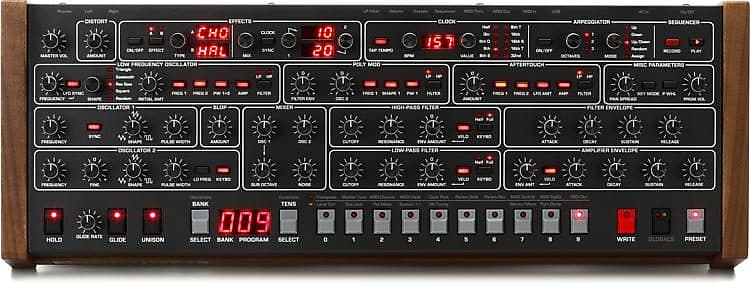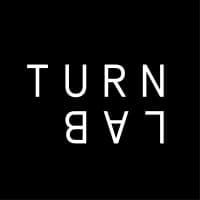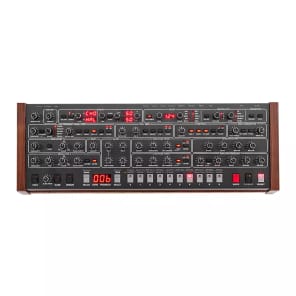The Prophet-6 desktop module is every bit as powerful and easy to use as its counterpart, the Prophet-6 Keyboard. The module has all of the same controls as the keyboard version and provides the same immediacy and ease of use — with absolutely no menu diving. As with the Prophet-6 Keyboard, all parameters are at your fingertips, with full-sized knobs and switches and a comfortable, intuitive layout.
How does it sound? Awesome — just like the keyboard, because on the inside, it’s exactly the same. The same analog signal path with discrete VCOs and VCFs. The same high-quality digital effects. The same classic sound that has been earning raves from customers and reviewers alike. Only added a poly chain feature so that any two Prophet-6s can be paired for twelve-voice polyphony!
Vintage with a Modern Twist— Both the Prophet-6 desktop module and keyboard are Dave Smith’s tribute to the poly synth that started it all—the Sequential Prophet-5. But it’s not simply a reissue of a classic. Rather, as Dave puts it, “It’s the result of our effort to build the most awesome-sounding, modern analog poly synth possible.” The Prophet-6 takes the best qualities of the original Prophet-5—true voltage-controlled oscillators, filters, and amplifiers—and adds enhancements such as studio-quality effects, a polyphonic step sequencer, an arpeggiator, and more. The result is pure, unadulterated analog tone with the stability and reliability of a state-of-the-art modern synth.
Classic Tone, Classic Vibe— Central to the warm, punchy sound of the Prophet-6 are its two newly-designed, discrete voltage-controlled oscillators (plus sub-oscillator) per voice. Continuously variable waveshapes provide the tonal palette with triangle, sawtooth, and variable-width pulse waves. There are two discrete filters per voice—a four-pole, resonant, low-pass inspired by the original Prophet-5 filter, and a two-pole, resonant, high-pass filter. Voltage-controlled amplifiers complete the all-analog signal path.
Dual Effects— The dual effects section provides studio-quality reverbs, delays (standard and BBD), chorus and phase shifter. While the effects themselves are digital, with 24-bit, 48 kHz resolution, a true bypass maintains a full analog signal path. There’s also an independent stereo distortion effect, which is 100% analog.
Poly Mod and Poly Step Sequencing— Also present from its classic predecessor is a Poly Mod section, with enhancements. True to the original, modulation sources are filter envelope and oscillator 2 (both with bi-polar control). Destinations include oscillator 1 frequency, oscillator 1 shape, oscillator 1 pulse width, low-pass filter cutoff, and high-pass filter cutoff. Another welcome reprise is Unison mode, which features configurable voice count (1-6 voices) and key modes. The polyphonic step sequencer allows up to 64 steps and up to 6 notes per step. You can create sequences polyphonically, with rests, and sync to an external MIDI clock. The full-featured arpeggiator can be synced to external MIDI clock as well.
Easy to Program— The knob-per-function front panel offers instant access to virtually all Prophet-6 functions. Included are 500 permanent factory programs and 500 rewritable user programs. Toggling off the Preset button enables live panel mode, in which the sound of the Prophet-6 switches to the current settings of its knobs and switches. In this state, what you see is what you hear.
Easy to Play— All of this awe-inspiring sound is packed into a desktop module that’s small enough to fit in a backpack. It’s an ideal combination of portability and power for the project studio or the gigging musician.
Specifications
- OSCILLATORS
- Two newly designed, discrete VCOs per voice
- Continuously variable wave shape (triangle, sawtooth, pulse, square) per oscillator
- Pulse width per oscillator
- Hard sync: oscillator 1 syncs to oscillator 2
- Triangle sub-octave generator (oscillator 1) per voice
- Low frequency mode (oscillator 2)
- Keyboard tracking on/off (oscillator 2)
- Oscillator slop amount for increased tuning instability, from subtle to extreme
- MIXER
- Oscillator 1 amount
- Oscillator 1 sub-octave amount
- Oscillator 2 amount
- White noise amount
- HIGH-PASS FILTER
- Two-pole, resonant, high-pass filter per voice
- Bi-polar filter envelope amount
- Velocity modulation of envelope amount
- Keyboard tracking: off, half, full
- LOW-PASS FILTER
- Four-pole, resonant, low-pass filter per voice, inspired by the original Prophet 5 filter
- Filter can be driven into self-oscillation with the Resonance control
- Bi-polar filter envelope amount
- Velocity modulation of envelope amount
- Keyboard tracking: off, half, full
- FILTER ENVELOPE — Four-stage (ADSR) envelope generator
- AMPLIFIER ENVELOPE
- Four-stage (ADSR) envelope generator
- Velocity modulation of envelope amount
- LOW FREQUENCY OSCILLATOR
- Five wave shapes: triangle, sawtooth, reverse sawtooth, square, and random (sample and hold)
- Clock sync (internal or external MIDI clock)
- Initial amount
- Mod destinations: oscillator 1 frequency, oscillator 2 frequency, oscillator 1 and 2 pulse width, low-pass filter cutoff, high-pass filter cutoff
- POLY MOD
- Sources: filter envelope (bi-polar) and oscillator 2 (bi-polar)
- Destinations: oscillator 1 frequency, oscillator 1 shape, oscillator 1 pulse width, low-pass filter cutoff, high-pass filter cutoff
- AFTERTOUCH
- Source: channel (mono) aftertouch with bi-polar amount
- Destinations: oscillator 1 frequency, oscillator 2 frequency, LFO amount, amplifier envelope amount, low-pass filter envelope amount, high-pass filter envelope amount
- CLOCK
- Master clock with tap tempo
- BPM control and display
- MIDI clock sync
- ARPEGGIATOR
- Selectable note value: 16th note, 8th note triplet, 8th note, dotted 8th note, quarter note
- One, two, or three octave range
- Up, down, up/down, random, and assign modes
- SEQUENCER — Polyphonic step sequencer with up to 64 steps and rests
- EFFECTS
- Stereo analog distortion
- Dual, 24-bit, 48 kHz digital effects, including: reverb (room, hall, plate, spring), delay (full bandwidth digital delay and emulated bucket brigade), chorus, flanger, phase shifters,
- and ring modulator
- Delay sync
- True bypass maintains fully analog signal path when digital effects are off
- PERFORMANCE CONTROLS
- Polyphonic glide (portamento)
- Hold switch latches held notes on
- Unison (monophonic) mode with configurable voice count, from one to all six voices, and key modes
- Preset switch: when off, the front panel is live; what you see is what you hear
- PATCH MEMORY
- 500 user and 500 factory programs in 10 banks of 100 programs each
- Direct program access, including Prophet 5-style single-button access to the current set of 10 programs
- IN/OUT
- Left and right audio outputs (2 x 1/4” phone jack)
- Headphone output (stereo, 1/4” phone jack)
- MIDI in, out, and thru ports
- USB for bidirectional MIDI communication
- Low-pass filter cutoff expression pedal input
- Volume expression pedal input
- Sustain footswitch input
- Sequencer start/stop footswitch input
- POWER
- IEC AC power inlet for internal power supply
- Operates worldwide on voltages between 100 and 240 volts at 50 to 60 Hz; 30 watts maximum power consumption
- PHYSICAL SPECS
- 21.25” L x 7.43” W x 4.4″ H (54.0 cm x 18.9 cm x 11.2 cm)
- 13.0 lbs (5.9 kg)
- Walnut end panels and trim


